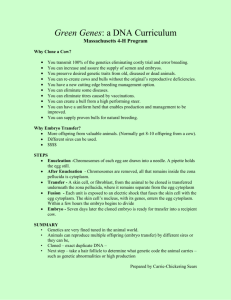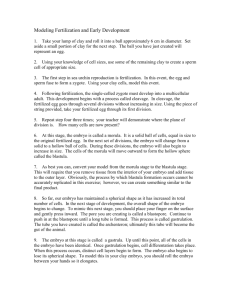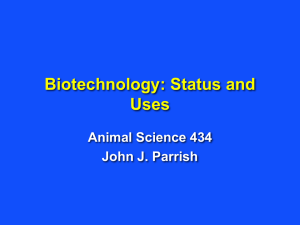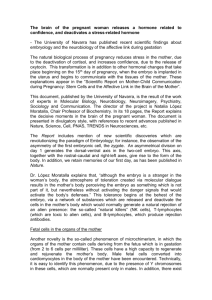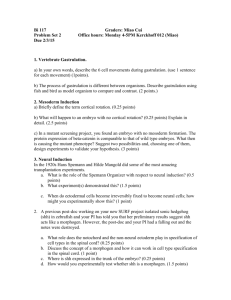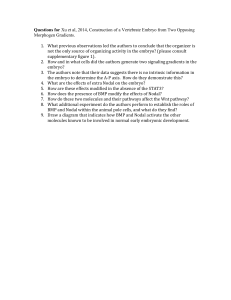November 2005
advertisement
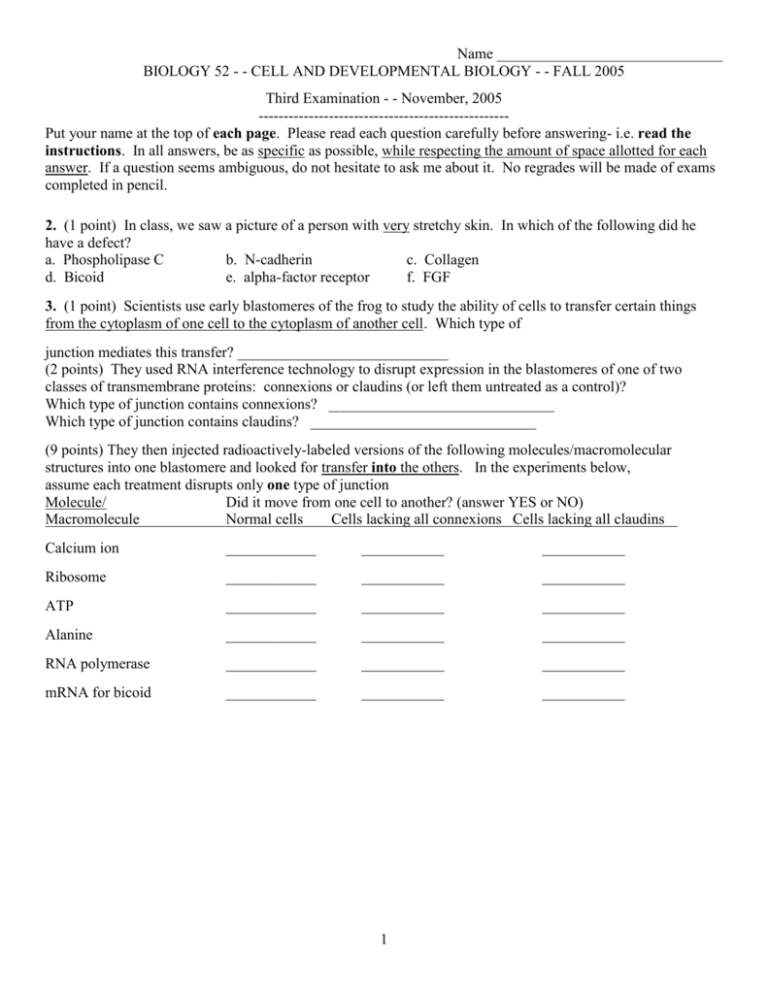
Name ______________________________ BIOLOGY 52 - - CELL AND DEVELOPMENTAL BIOLOGY - - FALL 2005 Third Examination - - November, 2005 -------------------------------------------------Put your name at the top of each page. Please read each question carefully before answering- i.e. read the instructions. In all answers, be as specific as possible, while respecting the amount of space allotted for each answer. If a question seems ambiguous, do not hesitate to ask me about it. No regrades will be made of exams completed in pencil. 2. (1 point) In class, we saw a picture of a person with very stretchy skin. In which of the following did he have a defect? a. Phospholipase C b. N-cadherin c. Collagen d. Bicoid e. alpha-factor receptor f. FGF 3. (1 point) Scientists use early blastomeres of the frog to study the ability of cells to transfer certain things from the cytoplasm of one cell to the cytoplasm of another cell. Which type of junction mediates this transfer? ____________________________ (2 points) They used RNA interference technology to disrupt expression in the blastomeres of one of two classes of transmembrane proteins: connexions or claudins (or left them untreated as a control)? Which type of junction contains connexions? ______________________________ Which type of junction contains claudins? ______________________________ (9 points) They then injected radioactively-labeled versions of the following molecules/macromolecular structures into one blastomere and looked for transfer into the others. In the experiments below, assume each treatment disrupts only one type of junction Molecule/ Did it move from one cell to another? (answer YES or NO) Macromolecule Normal cells Cells lacking all connexions Cells lacking all claudins Calcium ion ____________ ___________ ___________ Ribosome ____________ ___________ ___________ ATP ____________ ___________ ___________ Alanine ____________ ___________ ___________ RNA polymerase ____________ ___________ ___________ mRNA for bicoid ____________ ___________ ___________ 1 Name ______________________________ 4. (3 points) During fruit fly oogenesis the nurse cells and the oocyte are coupled by a special structure, which allows the transfer of things from the cytoplasm of the nurse cells to the cytoplasm of the oocyte. If scientists injected radioactively-labeled versions of each of the following molecules or macromolecular structures into a nurse cell and looked for transfer into the oocyte, what would the result be? ________________ Did it move from the nurse cell to the oocyte? (answer YES or NO) mRNA for bicoid ____________ Alanine ____________ Ribosome ____________ Mitochondrion ____________ DNA Polymerase ____________ Sodium ion ____________ 5. (2 points) Scientists were investigating the ability of small molecules to pass from one side of an epithelial sheet to the other. They added a fluorescent tracer on one side of the sheet. And examined its ability to diffuse between the cells to the other. In the experiment diagrammed, the tracer could only go a short distance before being stopped at a particular cell junction ________________________________ _________________________________ 6. (5 points) We discussed an experiment by Holtfreter in which he disassociated embryonic retinal and embryonic live cells. When he mixed them, they sorted out, forming aggregates that contained primarily either liver cells or retinal cells We now know which transmembrane proteins mediate this sorting: Retinal cells express ________________________ while liver cells express ___________________ What ion must be present for the cells to both sort and reaggregate (these transmembrane proteins rely on it for adhesion ______________________ 7. (1.5 points) Scientists began with yeast of the alpha-mating type, and mutated the gene encoding A-factor receptor so that it was no longer functional. With which sort of yeast would the mutant yeast mate? a. b. c. d. Both types. A mating type. Alpha mating type. Neither mating type. 8. (4 points) For the following cell types, fill in the blank to indicate whether they are somatic or germ cells. Endoderm ____________ Kidney____________ Uterus Follicle cell ____________ Oocyte ____________ Nurse cell ____________ Polar bodies ____________ Sperm ____________ 2 ____________ Name ______________________________ 9. (3 points—fill one letter in each blank) Based on the model I presented of gastrulation in the sea urchin, choose from the following experimental manipulations the one most likely to block each event. Ingression and migration of primary mesenchyme cells __________________ Initial formation of a dome-shaped invagination on the vegetal pole _____________ Elongation of the dome-shaped invagination into a gut tube ______________ A. Injection of antibodies to LH B. Use of RNA interference to block expression of all integrin genes into mRNA C. Genetic disruption of the folded gastrulation gene D. Injection of antibodies against a protein required for convergent-extension E. Use of a drug that inhibits contraction of actin and myosin filaments F. Treatment of animal pole cells with FGF 10. (2 points) During oogenesis of the fruit fly, the mRNA encoding bicoid is localized to which pole of the fruit fly embryo? _______________________________ Which cytoskeletal element is important for its transport to that site? _____________________ 11. (4 points) Match the term with the BEST definition (two choices will NOT be used) A. Enzyme that produces DAG and InsP3. B. Its mRNA is localized to the posterior end of the fruit fly egg. C. Its the receptor on mammalian sperm for the eggshell protein ZP3. D. Transcription factor that regulates mesoderm formation in the fruit fly. E. Cytoskeletal element that mediates cortical rotation. F. Protein involved in yeast mating. G. It phosphorylates proteins that regulate cellular pH. H. Protein involved in dorsal-ventral axis in Drosophila. I. Extracellular matrix protein involved in frog gastrulation. J. Cytoskeletal element with a key role in apical constriction Nanos ________ alpha-factor receptor ________ Microtubules ________ fibronectin ________ Toll receptor ________ Phospholipase C _________ Actin ________ Twist ________ 12. (4 points) To which of the three germ layers do each of the following cells belong or from which are they derived? Sea urchin secondary mesenchyme cells _________________ Lungs _________________ Peripheral nervous system _________________ Osteoblasts (make bone) _______________ Skin _________________ Follicle cells of the ovary _________________ Brain _________________ Intestine _________________ 3 Name ______________________________ 13. (4 points) For each of the following molecules, pick from among the following list the BEST definition of the job it does inside the cell or outside the cell (some answers MAY be used twice or NOT used at all). A. Transcription factor B. Steroid hormone C. Transmembrane protein D. Peptide or protein signaling molecule (ligand) E. Extracellular matrix component F. Ribosomal protein G. Mitochondrial protein H. Cytoskeletal protein Intermediate filaments _______ microtubules _______ Twist _______ Hyaluronic acid _______ Collagen _______ Toll _______ Integrin _______ FSH _______ Dorsal _______ Estrogen _______ 14. (3 points) For each of the following molecules, pick from among the following list the BEST choice for where within or outside the cell it would be located (some answers MAY be used twice or NOT used at all). A. Nucleus B. Mitochondrion C. Plasma membrane D. Cytoplasm E. Secreted outside the cell F. Lysosome Dorsal protein in embryo lacking Toll _______ FGF _______ Wingless _______ Folded gastrulation protein _______ N-cadherin _______ Dorsal protein in an embryo lacking cactus _______ 15. (2 points) Mammalian embryos, like other animals, undergo rapid cleavage divisions. At the 8-cell stage, a change occurs in the interactions between the cells. The picture at the far left is just before this transition, and that to its right is just after it. This change is called _________________. It can be blocked by exposing the embryo to antibodies that recognize which protein? _________________ 16. The following 4 true-or-false questions are worth 6 points in total. Mark each as T or F and for any that is/are false, indicate briefly why in the space below. a. T F Primary mesenchyme cells are part of the endoderm. b. T F Secondary mesenchyme cells ultimately make skeleton. c. T F Slime molds chemotax toward GTP. c. T F Translation does not begin until the midblastula transition. ____________________________________________________________________________ ____________________________________________________________________________ ____________________________________________________________________________ ____________________________________________________________________________ 4 Name ______________________________ 17. (2 Points) During embryonic development, different cells come to "express different genes". This involves the process called "transcription"-- what is transcription? ___________________ ____________________________________________________________________________ 18. (3 points) Individual actions by single cells, can, in concert, reshape the body plan of the embryo. At the left two sequential cell shape changes are diagrammed. Each is driven by a particular cytoskeletal element. Which type of cytoskeletal protein drives: Step A _____________________________ Step B ______________________________ Which of the two would be blocked by UV irradiation? _________________ 19. (Circle one-1 point) By messing around with fertilization, scientists created a haploid fertilized egg (rather than the usual diploid state), but it retained the normal amount of cytoplasm. How many rounds of cell divisions will it undergo before the onset of zygotic transcription? a. b. c. d. One more than normal. Two more than normal. One less than normal. Two less than normal. 20. (6 points--in each choose one from the following options; you may use the same letter twice if necessary) a. The embryo develops with two heads. b. The embryo develops no head; in fact it does not gastrulate. c. The embryo develops normally, with gastrulation lead by the cells descended from the donor gray crescent. d. The embryo strongly resembles James Moeser. e. The embryo develops normally, with gastrulation lead by the cells 180° opposite the donor gray crescent. f. The embryo grows up to go to Duke. Which letter best describes the result if a frog embryo injected with a drug that transiently depolymerizes microtubules just at fertilization? ________ Which letter best describes the result in which cells that form at the sperm entry point in a donor embryos are transplanted into an untreated host which thus has its own normal gray crescent?__________ Which letter best describes the result in which cells that form at the sperm entry point in a donor embryo are transplanted into a host embryo which had been treated to transiently depolymerize microtubules _______ 5 Name ______________________________ 21. (6 points- Put yes or no in each blank) A scientist sought to understand how the signal transduction pathway in the egg led to specific effects following fertilization. To test her hypotheses, she injected individual molecules into an unfertilized sea urchin egg. If she treated the egg as described, would these events occur? Cortical granule Increased cytoplasmic Increased protein release? calcium? synthesis? Cytoplasmic injection Of DAG ___________ ___________ ___________ Injection of Ca++ ___________ ___________ ___________ She also used inhibitors to try and block events—if she allowed an egg treated with the indicated inhibitors to be fertilized, would these events occur? Cortical granule Increased cytoplasmic Increased protein release? calcium? synthesis? Injection of chemical Inhibitor of Phospholipase C ___________ ___________ ___________ Injection of inhibitor Of the H+ transporter ___________ ___________ ___________ 22. (Fill in the blanks with STRONG or WEAK—4.5 points). In class we discussed experiments done by Dave McClay at “that other University in the Triangle”. These provided us with the basis for our current model for the first event of sea urchin gastrulation. In that experiment they measured the adhesion of three cell types to three substrates. Fill in the blanks, indicating whether the adhesion measured was STRONG or WEAK. 23. (4 points—choose the most likely answer and fill the letter in the blank) By analyzing the process of exocytosis, you have developed two specific inhibitors of processes involved in fertilization. What would be the most likely consequence of the following inhibitors: An inhibitor that blocks the fusion of the cortical granules with the plasma membrane _________ An inhibitor that blocks the fusion of the acrosomal vesicle with the plasma membrane _________ A. Prevents the sperm from locating the egg by chemotaxis B. Prevents the attachment of the sperm to the eggshell C. Prevents the sperm from penetrating the eggshell D. Prevents fusion of the sperm and egg plasma membranes E. Allows multiple sperm to fertilize the egg. In which cell type is the acrosomal vesicle ________________ In which cell type are the cortical granules ________________ 6 Name ______________________________ 24. (3 points—put the correct letter in the blank) This diagram illustrates the early stages of mammalian neurulation. Which cells will give rise to: Spinal cord and brain _________ Skin ________ Peripheral nervous system ________ 25. (4 points) We discussed the cellular and molecular events that lead to the production and patterning of mesoderm in the frog Xenopus. We discussed signaling between different cells in the embryo. The embryo starts with animal pole and vegetal pole cells. What germlayer is produced by animal pole cells cultured alone _____________ What germlayer is produced by animal pole cells cultured in the presence of vegetal pole cells ____________ What germlayer is produced by vegetal pole cells cultured alone _____________ What germlayer is produced by vegetal pole cells cultured in the presence of animal pole cells ____________ 26. (2 points) We also discussed how scientists identified signaling molecules that affect even finer scale decisions. From among the following choices, choose the most likely answer: What would be produced if animal pole cells are cultured in the presence of FGF? _________ What would be produced if animal pole cells are cultured in the presence of TGF-ß _________ A. Brain E. Stomach I. Dorsal mesoderm B. Ventral Ectoderm F. Ventral Mesoderm J. Hair C. Skin G. Lungs D. Dorsal endoderm H. Posterior mesoderm 27. (5 points) We discussed the role of Wingless in regulating cell-fate choice in the fruit fly embryonic epidermis. In this tissue, Wingless signaling normally directs cells into posterior cell fates, such that these cells secrete naked skin. Anterior cells secrete skin covered with small hairs. Choose from the list below the most likely result in the following situations: A. B. C. D. E. The embryo develops normally All cells within the segments take on posterior cell fates. No cells invaginate to form mesoderm. The head segments are lost. All cells within the segments take on anterior cell fates. An embryo homozygous mutant for wingless _________ An embryo homozygous mutant for the transcription factor activated by Wingless signaling __________ An embryo expressing a mutant copy of the gene encoding the transmembrane receptor for Wingless: this mutation makes the receptor active even in the absence of its ligand _____________ An embryo genetically engineered such that all cells express high levels of Wingless _____________ An embryo heterozygous mutant for wingless _________ I certify that I performed my work on this examination in full conformity with the provisions of the Honor Code. Signature___________________________________ 7


